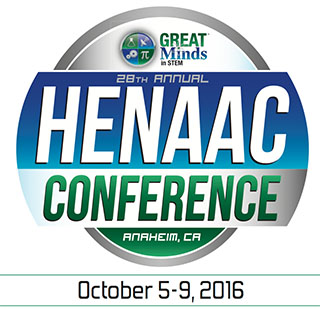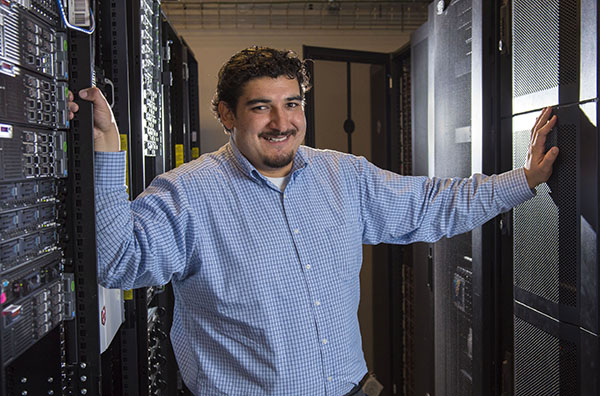Sandia researchers earn top Hispanic science and engineering honors

Two outstanding Sandia innovators have been recognized nationally for their technical achievements with 2016 HENAAC Awards from Great Minds in STEM. Chemist Bernadette “Bernie” Hernandez-Sanchez (1815) has won Outstanding Technical Achievement, and cybersecurity researcher Vincent Urias (9526) was named
a Luminary Honoree. While the talents of these two researchers span very different fields of science, their commonalities are remarkable: Both grew up in impoverished areas of Albuquerque, attended underserved Albuquerque Public Schools high schools, started at the Labs as high school interns, and were the first in their families to go to college.
HENAAC, formally the Hispanic Engineering National Achievement Awards Conference, honors Hispanic researchers who have made significant contributions to the nation’s technical community. Awardees are peer-reviewed and come from a wide range of private industry, academia, military, and government organizations. Bernie and Vincent will be recognized with other national winners at the 28th annual HENAAC Conference in Anaheim, California, Oct. 5-9, during National Hispanic Heritage Month.
Bernie Hernandez: A Material Girl
“The first time I ever met a scientist was when I started my internship at Sandia,” says Bernie, who is from Albuquerque’s South Valley, where few people she knew went to college. Today, she is a highly accomplished chemist, and the first woman at the Labs to receive the prestigious HENAAC award for Outstanding Technical Achievement.
“This award is gratifying,” Bernie says. “I am so thankful. There is still so much more work I want to do. What I love about chemistry is making new materials, and seeing how those materials can be applied to so many different aspects of our community and our world.”
Bernie’s technical achievements focus on the morphology, structure, and properties of nanomaterials for real-world applications ranging from renewable energy to homeland security. As the principal investigator on Sandia’s Marine & Hydrokinetic Advanced Materials Program, Bernie’s work has made strides in the field of water power. She studies materials challenges such as corrosion for underwater devices that aim to harness clean energy for electricity. In one such project she is developing nano-engineered copper-silver coatings to keep microorganisms from growing on equipment. She says the coatings come from techniques she has spent more than 10 years developing in Sandia’s Advanced Materials Lab (AML).
I like to give back, because I look at them and see myself.
In another project, Bernie works with a local company, bioLime®, through the New Mexico Small Business Assistance program. She is helping the business improve the chemistry of stucco, a staple material in Southwestern homes that is prone to aging and cracking.
Bernie has also contributed to Sandia’s NanoCRISPR Grand Challenge project, funded by the Laboratory Directed Research and Development program, and to the improved chemistry of lithium-ion batteries and ferroelectric perovskite materials.
She holds a PhD in inorganic solid state chemistry from Colorado State University and a bachelor’s degree in chemistry from New Mexico Institute of Mining and Technology. She has published 28 technical papers and has been awarded two patents.
Bernie says her longtime mentor at the AML, chemist Tim Boyle (1815), has been among her most important role models.
“Bernie’s expertise in solving complex materials problems is on the cutting edge of many fields,” says Tim. “In addition to her technical work, she is dedicated to increasing the number of students entering science by tirelessly donating her time and effort.”
Bernie has mentored more than 50 student interns in her lab, many of whom have gone on to pursue graduate degrees in chemistry. Sonia Mendoza, a chemistry student from Universidad del Valle de Mexico says, “Working with Bernie, I learned to challenge myself and that anything is possible, no matter your background. Bernie taught me to not always trust published work, but to prove things yourself through science.”
Maddison Casillas, a freshman at UNM who works in her lab, says, “Bernie has spent countless hours just explaining concepts to me. She has not only taught me chemistry, but she has also taught me lessons that have helped me with my everyday life.”
In addition to helping undergraduates succeed, Bernie works with elementary and middle school students from underrepresented communities to get them excited about science. “I like to give back, because I look at them and see myself. I understand the importance of being introduced to new concepts and role models in order to encourage student interest.” she says.
It’s that passion that got her involved in Sandia’s MANOS program for Hispanic youth, where she volunteered in the community teaching basic chemistry classes. From her MANOS curriculum evolved the CSI: Dognapping Forensics Program — a lively, interactive outreach program she designed with Tim Boyle to show kids that science is fun. CSI: Dognapping has since reached 5,000 local schoolchildren, and was honored by the American Chemical Society with the 2015 ChemLuminary Award for Outstanding Kids & Chemistry.
“Bernie is one of the most dedicated volunteers at Sandia,” says Amy Tapia (3652),Community Involvement manager. “She has lived the journey herself and is eager to help others. She supports students through meaningful programs that provide them with the skills they need to be successful.”

Vincent Urias was named a HENAAC Luminary Honoree, which recognizes professionals in science, technology, engineering, and mathematics who initiate, collaborate, and lead key programs and research within their companies. (Photo by Randy Montoya)
Vincent Urias: “Just do it”
Vincent was raised by his grandparents, who immigrated to the US from Guatemala in the 1960s, fleeing persecution. He says they instilled in him a love of the United States and the value of service. Speaking about his grandmother Josephine today, Vincent says, “I can’t slow her down. She is in her 80s, volunteering four days a week in a first grade classroom, and walking to work every day.”
Vincent, too, is a non-stop force of energy. He has achieved notable success in Sandia’s cyber defense programs, supporting national security for partners including the US Department of Defense. His research includes large-scale cyber modeling and simulation environments at Sandia, called Emulytics™, that have allowed for the testing of software systems at the scale of large enterprises. From that work came a striking innovation that earned him a patent — an advanced security technology called Deception.
Says Vincent’s manager, David Duggan (9526), “To be able to perform this type of testing before deploying software systems was a capability missing from the software engineer’s toolbox until now. Vincent is the visionary and driving force behind these innovations.”
The curriculum is going to be hard, but just do it. You can succeed.
Vincent holds a master’s degree in computer science and a bachelor’s degree in electrical engineering from New Mexico Institute of Mining and Technology. He is completing a PhD at New Mexico Tech in computer science.
Amidst work and school projects, Vincent has mentored more than 25 undergraduate students at Sandia. His manager says, “He’s got an infectious attitude and an outstanding work ethic that students can see and want to emulate themselves. He enables them to want to learn and do more in this field.”
Outside the lab, Vincent volunteers at the Hispanic Cultural Center to encourage minority students to pursue STEM education. He also serves as Stewardship chair of the United Way of Central New Mexico’s Hispanic Philanthropic Society, designing strategies to invest in local middle school youth.
Vincent says his advice to underserved students who are interested in STEM careers is, “The curriculum is going to be hard, but just do it. You can succeed.”
Vincent grew up in the low-income sector of Albuquerque informally known as “The War Zone,” or, the International District. Amidst a neighborhood occupied with gangs and drugs, his grandfather Alfred drove him to and from school every day, and retired “to focus on taking care of me,” Vincent says. “He thought it was a big job.” Vincent credits his drive to both of his grandparents, who taught him to never stop trying, and don’t be afraid to fail, he says.
At age 15 Vincent got a job at Sandia, working as an intern-level tech in the computer support unit (CSU). He tributes his success to the mentors he still calls his “adoptive parents” — Susan Sackinger, his first supervisor at Sandia, and her husband Phil Sackinger (5524) who mentored him in Sandia’s Engineering Science Center.
“I did not even know I was going to college until I came to Sandia,” Vincent says. “Being exposed to the talent, the technology, and the people here changed my life.”